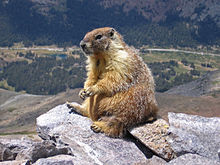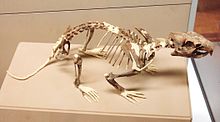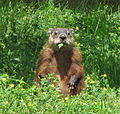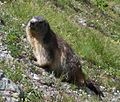- Marmot
-
For other uses, see Marmot (disambiguation).
Marmot
Temporal range: Late Miocene–Recent
Yellow-bellied Marmot in Yosemite National Park Scientific classification Kingdom: Animalia Phylum: Chordata Class: Mammalia Order: Rodentia Family: Sciuridae Subfamily: Xerinae Tribe: Marmotini Genus: Marmota
Blumenbach, 1779Species Marmota baibacina
Marmota bobak
Marmota broweri
Marmota caligata
Marmota camtschatica
Marmota caudata
Marmota flaviventris
Marmota himalayana
Marmota marmota
Marmota menzbieri
Marmota monax
Marmota olympus
Marmota sibirica
Marmota vancouverensisThe marmots are a genus, Marmota, of squirrels. There are 14 species in this genus.
Marmots are generally large ground squirrels. Those most often referred to as marmots tend to live in mountainous areas such as the Alps, northern Apennines, Eurasian steppes, Carpathians, Tatras, and Pyrenees in Europe and northwestern Asia; the Rocky Mountains, Black Hills, Cascades, and Sierra Nevada in North America; and the Deosai Plateau in Pakistan and Ladakh in India. The groundhog, however, is also properly called a marmot, while the similarly sized but more social prairie dog is not classified in the genus Marmota but in the related genus Cynomys.
Marmots typically live in burrows (often within rockpiles, particularly in the case of the Yellow-bellied marmot), and hibernate there through the winter. Most marmots are highly social, and use loud whistles to communicate with one another, especially when alarmed.
Marmots mainly eat greens and many types of grasses, berries, lichens, mosses, roots and flowers.
Contents
Species
The following is a list of all Marmota species recognized by Thorington and Hoffman (2005).[1] They divide marmots into two subgenera.
- Genus Marmota – marmots
- Subgenus Marmota
- Alpine Marmot, Marmota marmota found only in Europe in the Alps, northern Apennines in Italy, Carpathians, Tatras, and reintroduced in the Pyrenees
- Gray Marmot or Altai Marmot, Marmota baibacina found in Siberia
- Bobak Marmot, Marmota bobak found from central Europe to central Asia
- Alaska Marmot, Brower's Marmot, or Brooks Range Marmot, Marmota broweri found in Alaska
- Black-capped Marmot, Marmota camtschatica found in eastern Siberia
- Long-tailed Marmot, Golden Marmot, or Red Marmot, Marmota caudata found in central Asia
- Himalayan Marmot or Tibetan Snow Pig, Marmota himalayana found in the Himalayas
- Menzbier's Marmot, Marmota menzbieri, found in central Asia
- Groundhog, Woodchuck or Whistlepig, Marmota monax found in most of North America
- Tarbagan Marmot, Mongolian Marmot, or Tarvaga, Marmota sibirica found in Siberia
- Subgenus Petromarmota
- Hoary Marmot, Marmota caligata found in northwestern North America[clarification needed]
- Yellow-bellied Marmot, Marmota flaviventris found in southwestern Canada and western United States
- Olympic Marmot, Marmota olympus endemic to the Olympic Peninsula, Washington, USA
- Vancouver Island Marmot, Marmota vancouverensis endemic to Vancouver Island, British Columbia, Canada
- Subgenus Marmota
Additionally, four extinct species of marmot are recognized from the fossil record:
- Marmota arizonae, Arizona, U.S.
- Marmota minor, Nevada, U.S.
- Marmota robusta, China
- Marmota vestus, Nebraska, U.S.
History and etymology
Marmots have been known since antiquity. Research by the French ethnologist Michel Peissel makes a claim that the story of "gold-digging ants" reported by the Ancient Greek historian Herodotus, who lived in the 5th century BC, was founded on the golden Himalayan Marmot of the Deosai plateau and the habit of local tribes such as the Minaro to collect the gold dust excavated from their burrows.[2]
The etymology of the term "marmot" is uncertain. It may have arisen from the Gallo-Romance prefix marm-, meaning to mumble or murmur (an example of onomatopoeia). Another possible origin is post-classical Latin, mus montanus, meaning "mountain mouse".[3]
Beginning in 2010, Alaska celebrates February 2 as "Marmot Day", a holiday intended to observe the prevalence of marmots in that state and take the place of Groundhog Day.[4]
Human consumption
Marmots have been eaten for centuries in the native cuisine of Mongolia, where they are called tarvaga, and in particular are used to make a dish called boodog.[5] Hunting of marmots for food is typically done in seasons and time periods when the animals are heavier.[example needed]
Carriers of plague
Pneumonic plague can be spread by marmots.[6][7]
Examples of species
-
A Yellow-bellied Marmot (Marmota flaviventris), near Princeton, British Columbia
-
A Hoary Marmot (Marmota caligata), Mt. Rainier National Park
-
Alpine Marmot in the Massif des Écrins, southern France
-
Drawing of Bobak Marmot (Marmota bobak)
-
Olympic Marmot (Marmota olympus)
-
Black-capped Marmot (Marmota camtschatica)
-
Golden Marmot (Marmota caudata), Pakistan
-
Himalayan Marmot (Marmota himalayanus), Bhutan
-
Grey Marmot (Marmota baibacina), Altai Mountains, Kazakhstan
References
- ^ Thorington, R. W., Jr., and R. S. Hoffman. 2005. "Family Sciuridae". Mammal Species of the World: A Taxonomic and Geographic Reference, pp. 754–818. D. E. Wilson and D. M. Reeder, eds. Johns Hopkins University Press, Baltimore.
- ^ Peissel, Michel. "The Ants' Gold: The Discovery of the Greek El Dorado in the Himalayas". Collins, 1984. ISBN 978-0002725149.
- ^ "Marmot". Oxford English Dictionary. Oxford University Press. 2nd ed. 1989.
- ^ The Associated Press. "Alaska to Celebrate its First Marmot Day", Fairbanks Daily News-Miner. Feb. 1, 2010. Accessed Feb. 1, 2010.
- ^ "Boodog: Hot Stones in Stomach". Cuisine of Mongolia. http://www.mongolfood.info/en/recipes/boodog.html. Retrieved 2009-11-27.
- ^ "Plague breaks out in China's Tibet". The Sydney Morning Herald. September 26, 2010. http://news.smh.com.au/breaking-news-world/plague-breaks-out-in-chinas-tibet-20100926-15s6z.html.
- ^ The Shifting Explanations for the Black Death, the Most Devastating Plague in Human History
External links
Categories:- Ground squirrels
- Marmots
- Mammals of North America
- Mammals of Europe
- Mammals of Asia
- Genus Marmota – marmots
Wikimedia Foundation. 2010.












